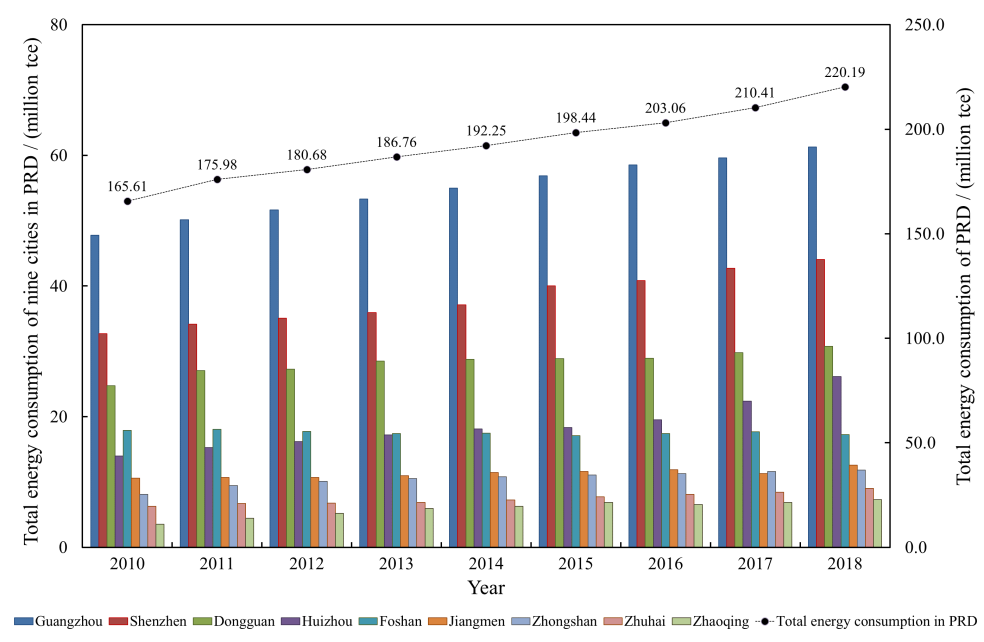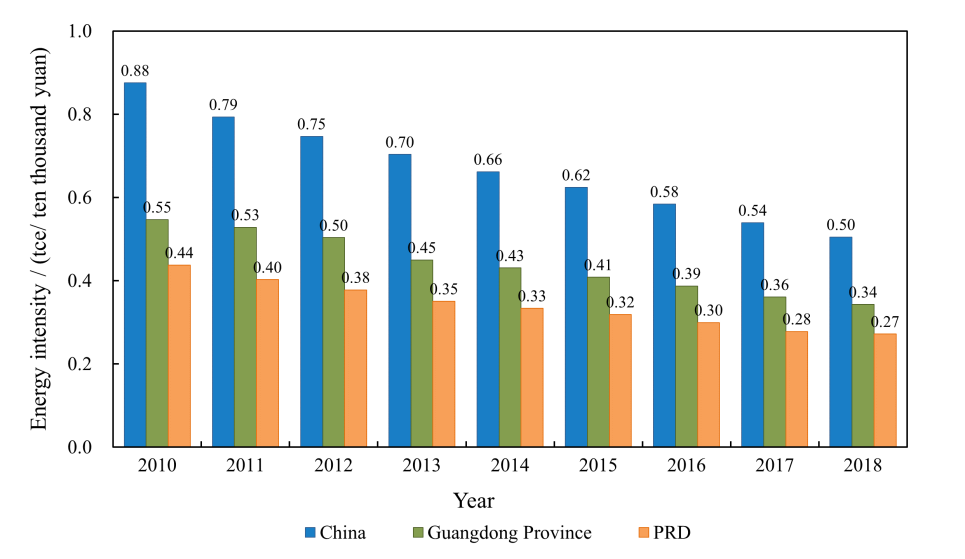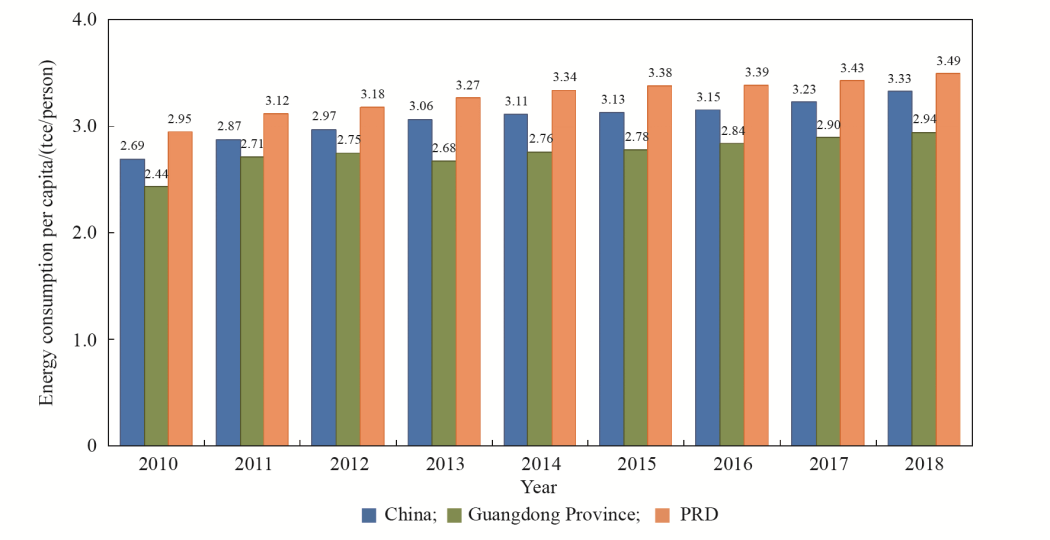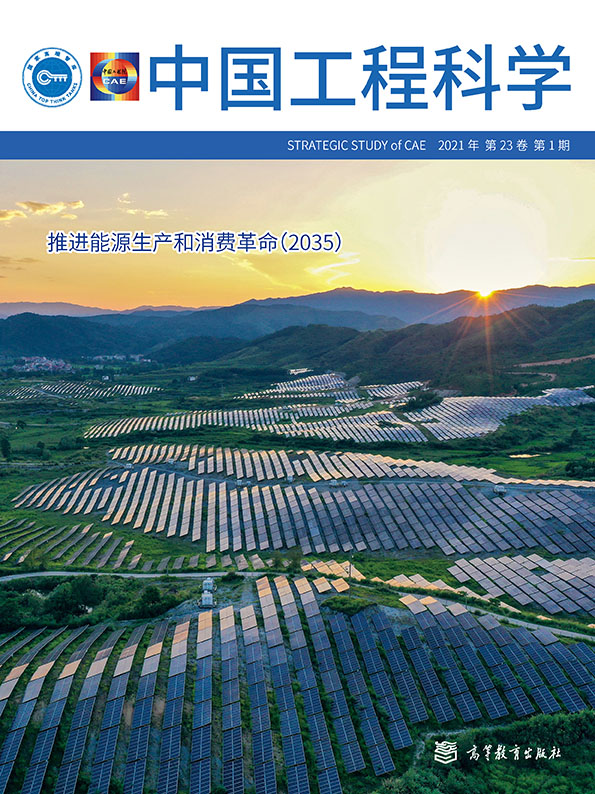《1 Introduction 》
1 Introduction
The Pearl River Delta (PRD) region is the main area where China’s Belt and Road initiative and the Guangdong– Hong Kong–Macao Greater Bay Area construction are implemented [1]. The PRD has experienced high levels of open development and aims to achieve higher economic and social development. Specifically, the main goals are to promote coordinated development with surrounding areas, integrate the construction of Guangdong–Hong Kong– Macao Greater Bay Area, serve the Belt and Road initiative, and help the construction of regional ecological development. Furthermore, the PRD plays an important role in China’s strategy regarding energy production and consumption. The energy revolution promoted open development of the PRD region. This is of great significance for improving energy quality and efficiency, enhancing the capacity for energy security, forming a green and lowcarbon energy development system, and promoting the coordinated development of energy and environmental protection. Therefore, the energy revolution will elevate the PRD into a high-quality regional socioeconomic development stage. Based on regional resources and the actual developmental stage, this study comprehensively analyzed the energy supply and consumption characteristics in the PRD region. The challenges faced by the energy revolution in promoting the open development of the PRD are discussed, and some relevant measures and suggestions for how the energy revolution can accelerate the open development of the PRD in a sustainable way, are proposed.
《2 Energy development in the PRD Region 》
2 Energy development in the PRD Region
《2.1 The characteristics of energy supply》
2.1 The characteristics of energy supply
Coal supply in the PRD mainly depends on transportation from other provinces or countries. Since the last coal industry in Shaoguan, Guangdong province, was closed in 2005, the PRD region has been acquiring coal from other provinces or countries. Most of the coal is transferred from the northern parts of China, including Shaanxi Province, Shanxi Province, and the Inner Mongolia Autonomous Region, where superior blended coal was produced. Additional coal is mainly imported from Indonesia and Australia, and a small amount from Vietnam and Russia. Because the PRD region is near major international coal exporting countries, imported coal generally has a lower price than that of domestic coal. As a result, imported coal has become an important source of energy in this region.
Oil storage, transportation, and processing capabilities in the PRD have improved. Crude oil processed in the PRD region mainly comes from the South China Sea oilfields, other Chinese provinces, or abroad. It is mainly transported through oil pipelines and seaports. The PRD region has a well-developed industrial system, including 96 petroleum processing companies, 98% of which are engaged in the manufacturing of refined petroleum products. The region’s petroleum storage and transportation capabilities have been constantly improving. Large-scale refining and chemical companies include the Guangzhou Petrochemical Company and Huizhou branch of the China National Offshore Oil Corporation (CNOOC). Both produce gasoline, diesel, kerosene, and chemical raw materials with a crude oil processing capacity of 35.2 million metric tons per year [2].
The PRD region has formed an inner and outer network of the natural gas supply. As of 2017, the PRD region has formed a “multi-source complementary, nearby supply” gas supply network [3], including imported liquefied natural gas, natural gas through inter-provincial long-distance pipelines, and offshore natural gas. Seven natural gas supply projects have been completed, including Shenzhen Dapeng, CNOOC Shenzhen Diefu, CNOOC Zhuhai Jinwan, China National Petroleum Corporation Second Line Guangdong Section, Zhuhai Hengqin Island, Gaolan Port, and Dongguan Jiufeng, with a supply capacity of 40.1 billion m3 per year. The main natural gas pipeline network in the PRD region is 2200 km long, extending from Zhuhai and Jiangmen to Zhaoqing, connecting Guangzhou through Qingyuan and Conghua. It reaches Dongguan and Huizhou in the east-central region, forming an inner and outer network in the PRD region, connecting the gas transmission network in the northwestern Guangdong area.
The external dependence of power in the PRD region accounts for approximately 50%. All cities in the PRD region, except for Zhuhai, require an external power supply. This power supply comes from China’s western provinces and also from the eastern, western, and northern parts of Guangdong Province. In 2017, total power consumption in the PRD region was 442.3 billion kWh, with the local self-powered supply accounting for 220.9 billion kWh, exhibiting a self-sufficiency rate of 49.9%. The total installed power capacity in the PRD region is 52.32 million kilowatts, of which coal, gas, nuclear energy, and renewable energy account for 49.8%, 31.3%, 11.7%, and 7.3%, respectively. The general trend of power development in the PRD is to reduce the proportion of coal-fired power, while the power generation and supply capacity of gas, nuclear, and renewable energy is increasing.
《2.2 The characteristics of energy consumption》
2.2 The characteristics of energy consumption
Total energy consumption and the energy consumption proportions of tertiary industries and daily domestic activities have increased continuously. The total energy consumption of nine cities in the PRD region has been growing, with an average annual growth rate of 6.8%, from 2010 to 2018, reaching 220 million ton of standard coal equivalent (tce) in 2018. This accounted for 94.7%, 66.1%, and 4.74% of the total energy consumption in Guangdong–Hong Kong–Macao Greater Bay Area, Guangdong Province, and China, respectively. Guangzhou, Shenzhen, and Dongguan have always been the top energy consumers, at 61.3 million tce, 44.05 million tce, and 30.66 million tce in 2018, respectively (Fig. 1). According to the data of energy consumption structure in the whole province, the proportion of natural gas and non-fossil fuel energy consumption increased, accounting for 8.3% and 26.4%, in 2018, respectively. The proportion of tertiary industry and daily domestic energy consumption has also increased, accounting for 23.2% and 15.7%, in 2018, respectively (Fig. 2).
《Fig. 1》

Fig. 1. Energy consumption of nine cities in the PRD region, and total PRD energy consumption, from 2010 to 2018 [4].
《Fig. 2》

Fig. 2. Energy consumption of Guangdong Province in 2018 [4].
Energy intensity gradually decreased across the period 2010 to 2018. The average growth rate of energy consumption per unit of GDP in China, Guangdong Province, and the PRD were −6.6%, −5.6%, and −5.8%, respectively. The energy consumption per unit of GDP of the PRD in 2018 was 0.27 tce/ten thousand yuan, which is 46.0% and 20.6% lower than that of China and Guangdong Province, respectively (Fig. 3). However, the level of energy consumption in the PRD is approximately two to three times that of the Tokyo Bay Area, the San Francisco Bay Area, and the New York Bay Area [5]. As such, there is much room for improvement in terms of energy intensity in this region.
《Fig. 3》

Fig. 3. Energy consumption per unit of GDP from 2010 to 2018 [4].
Energy and electricity consumption per capita continue to increase annually. From 2010 to 2018, energy consumption per capita in China, the Guangdong Province, and the PRD has been increasing. In 2018, energy consumption per capita in the PRD reached 3.49 tce/person, 18.7% higher than that of Guangdong Province and 4.8% higher than that of China (Fig. 4). This is because the PRD region is more economically developed than the eastern, western, and northern regions of Guangdong Province, and because the living standard in this region is relatively high. During this period, total electricity consumption in the PRD increased from 306.6 billion kWh to 467.3 billion kWh, a 52.4% increase. Electricity consumption per capita increased from 5459 kWh/person to 7416 kWh/person, a 35.8% increase (Fig. 5). The growth in electricity consumption in the entire PRD area is higher than the growth in energy consumption, which reflects a strong trend toward electrification. Electricity consumption per capita is expected to increase continuously in the future.
《Fig. 4》

Fig. 4. Energy consumption per capita from 2010 to 2018 [4].
《Fig. 5》

Fig. 5. Electricity consumption of nine cities in the PRD region from 2010 to 2018 [4].
《2.3 Analysis of energy balance between supply and demand》
2.3 Analysis of energy balance between supply and demand
Fig. 6 shows the changes in the energy balance, between supply and demand, in Guangdong Province, from 1990 to 2018. The energy input (from other provinces and from other countries) increased from 34.29 million tce in 1990 to 364 million tce in 2018, an almost 11-fold increase. The net energy input (input to Guangdong Province minus output from Guangdong Province) increased from 31.62 million tce in 1990 to 265.44 million tce in 2018, with an average growth rate of 6.5%. During this period, the proportion of net energy input to available energy in Guangdong Province was equivalent to an average of 77.9%, except for the period from 1995 to 2005. In particular, the energy imported from other countries in 2018 accounted for almost half of the energy input. This demonstrates that Guangdong Province, especially the PRD region, has few energy resources and is highly dependent on external energy. Therefore, it is important to encourage energy opening and cooperation in the regional energy revolution.
《Fig. 6》

Fig. 6. The amount of energy input and output for the Guangdong Province from 1990 to 2018 [4].
《3 Challenges faced by the energy revolution in promoting the open development of the PRD》
3 Challenges faced by the energy revolution in promoting the open development of the PRD
The security of energy supply in the PRD must be improved. In 2018, the energy self-sufficiency rate in Guangdong Province was only 23.5%. The external dependence rates of raw coal, crude oil, and natural gas were 100%, 76.5%, and 45.4%, respectively. The external dependence of the energy supply in the PRD region exceeded 80%. The electricity consumption in Guangdong Province amounts to 632.34 billion kWh, and a self-sufficiency rate of 72.3%. In addition, the self-sufficiency rate of the power supply in the PRD region is less than 50%, lower than the average level of Guangdong Province. It relies heavily on external power supply. Given the limited energy resources available and lack of energy reserves, it is a challenge to meet the very large energy demand of the new round of economic construction and social development in the PRD.
The energy supply structure still needs to be further optimized. In 2018, natural gas consumption in Guangdong Province accounted for only 8.3% of total energy consumption, while the proportion of non-aqueous renewable energy accounted for only 1.2%. The proportion of natural gas and non-aqueous renewable energy is much lower than that in OECD countries and developed countries, including the United States and Japan. The power supply structure in the province remains dominated by coal. The proportion of installed capacity for power supply from clean energy remains low. In particular, the proportion of installed capacity for power supply from renewable energy sources, such as photovoltaics and wind power, needs to be increased. Although there are some problems with photovoltaic and wind power energy, including low density and few power generation hours, there is great potential to develop renewable energy in the PRD, which is characterized by land-use intensification, weak local power supply, and high distribution network load.
There is a contradiction between demand and control of total consumption of energy. As part of the 13th FiveYear Plan, Guangdong Province implemented a “dual control” policy for total energy consumption and energy intensity. It delegated the control indicators for prefectures and cities for evaluation. At present, the total energy consumption control can be completed after implementation of the coal-to-gas conversion measures for the selfowned power plant of the Dongguan Paper Mill. However, other cities in the PRD region face significant difficulties in achieving the total energy consumption control target. The total energy consumption index is not sufficient because it limits urban development and needs to be adjusted according to the actual situation.
There is a large gap in environmental quality between the PRD region and comparable international Greater bay areas. In 2018, the annual average PM2.5 concentration in the PRD region was 34 µg/m3 , 2–3 times that of the Tokyo Bay Area, the New York Bay Area, and the San Francisco Bay Area [6]. The energy supply structure in the PRD region has been optimized in recent years. Energy efficiency is continually improving, and the proportion of clean energy has increased. Nevertheless, the environmental pollution caused by energy utilization remains serious due to the increase in total energy consumption and unreasonable industrial structure, and there is a clear gap in environmental quality compared with the aforementioned three international greater bay areas. The PRD region has also committed to take the lead in reaching the peak of carbon emissions in China and Guangdong Province. Therefore, PRD is under significant pressure for ecological and environmental protection.
Mechanisms for the reform of the energy system mechanism should be implemented effectively. Policies for total energy consumption control, the policy for “dual control”, and indicators for energy saving and emission reductions, need to be further improved. Therefore, it is necessary to formulate a system of scientific benchmarking. In certain regions, the cities of different stage of development should be differentiated in terms of the quantitative evaluation of energy consumption. While quantitative evaluation should be emphasized, quality evaluation should also be taken into consideration to promote the construction of a modern energy system. A market-oriented reform of the energy control system should be implemented effectively through a top-level design.
《4 Demand for energy revolution in the open development of the PRD》
4 Demand for energy revolution in the open development of the PRD
《4.1 It is necessary to find fresh momentum for economic growth during the period of coordination of supply and demand of energy》
4.1 It is necessary to find fresh momentum for economic growth during the period of coordination of supply and demand of energy
The PRD is a region where China’s new rounds of reform and opening-up policies have been implemented. This region is actively leading the new form of economic development, accelerating the revolution in energy production and consumption, achieving breakthroughs in alternative energy technology and equipment, further expanding international energy cooperation, and continuing to stimulate the development potential of the reform and openingup policies. The PRD represents a new model that can be replicated and popularized, thereby playing a leading role in national social and economic development. In the new economy, there is a balance between the supply and demand of traditional energy, and the development of future energy supplies will focus on renewable energy. In 2017, China accounted for nearly one-third of the total global investment in renewable energy. Relevant predictions show that the rate of contribution of Guangdong’s alternative energy industry to economic growth can exceed 10% by 2030 [7], forming a new driving force for economic growth.
《4.2 Decision makers need to solve the problem of unbalanced and uncoordinated energy development》
4.2 Decision makers need to solve the problem of unbalanced and uncoordinated energy development
Optimization of the energy consumption structure in the PRD region presents an ongoing challenge. Increasing the consumption of natural gas is key to adjusting the energy structure in the PRD, both in the short- and mid-term. However, there are currently many obstacles to increasing natural gas consumption, including limited natural gas resources, limited transmission and storage facilities, inadequate large-scale utilization models, and price mechanisms. In the long-term the main direction of energy transformation in the PRD region is to comprehensively improve the quality of renewable energy supply. This region can develop clean energy, including onshore and offshore wind, solar, and biomass energy, to gradually change the energy consumption structure. Additionally, to ensure coordinated development between the rates of growth of total energy consumption and economic development, some manufacturing industries in this region are shifting to the eastern, western, and mountainous areas of Guangdong Province. This reduces the energy consumption per unit of output value in the PRD. The complementary advantages of the PRD region and the eastern, western, and mountainous regions of Guangdong Province can lead to economic and energy exchanges. This can promote the economic development of these areas while improving energy security in the PRD.
《4.3 Decision makers must solve the problem of energy planning and allocation in the main functional areas》
4.3 Decision makers must solve the problem of energy planning and allocation in the main functional areas
The PRD region is an optimized development area within Guangdong Province and is also a major area for urban and industrial development. Wind power is mainly located in coastal and mountainous areas, in the northern and western regions of Guangdong, while photovoltaic power generation is mainly concentrated in the eastern and western coastal areas. The PRD and other regions of Guangdong Province need to benefit from their advantages to promote the two-way exchange of energy and economic activity. The economic integration and increasing population in the Greater Bay Area will create new energy demands. A new mechanism for energy cooperation that is mutually beneficial will be established by developing a blueprint for energy interconnection in the greater bay area. The energy transformation of the Greater Bay Area will create economic opportunities and markets for technological innovation and the development of emerging industries. This includes smart manufacturing, high-end equipment, zero-carbon buildings, and new energy generating industries.
《4.4 It is necessary to ensure the optimization of energy resource allocation and supply security》
4.4 It is necessary to ensure the optimization of energy resource allocation and supply security
Currently, new energy companies in China are actively investing overseas and have cooperated with more than 80 countries in the fields of hydropower, photovoltaics, wind power, and solar thermal utilization [8]. The strategic target of the PRD region is to become the starting point of the Maritime Silk Road, focusing on energy-industry cooperation in Southeast Asia and, at the same time, playing a leading role in the inland southwestern region and southern China. It is necessary for the PRD region to develop power interconnections and to participate in the construction of energy production and distribution infrastructure through technology exports to achieve energy security. The countries participating in the One Belt One Road initiative are achieving energy cooperation. This type of cooperation can not only solve the problem of energy shortage in the PRD region, but it can also overcome the restrictions this imposes on economic development in some regions. The PRD should give full play to its advantages in finance, manufacturing, and service industries. It should transform these capital and technological advantages into initiatives for practical cooperation to promote the overall economic development of countries participating in the Belt and Road initiative.
《4.5 It is necessary to ensure the transition of energy-intensive and high-polluting industries to green industries》
4.5 It is necessary to ensure the transition of energy-intensive and high-polluting industries to green industries
Air quality in the PRD remains lower than that in other international bay areas. To achieve the goal of building a world-class developed region with a healthy and beautiful natural environment, the PRD must develop green and low-carbon energy supplies and establish an energy supply system based on new energy supplies that are compatible with the region’s strong economic growth. The PRD is accelerating the optimization and upgrading of industrial structures. It is currently investing in advanced materials, high-end equipment manufacturing, new energy supplies, and other strategic emerging industries. It also seeks to encourage technological transformation and innovation, improve energy efficiency, and reduce product energy consumption.
《5 Measures and suggestions》
5 Measures and suggestions
《5.1 Relying on the Belt and Road initiative and Guangdong–Hong Kong–Macao Greater Bay Area to build an energy reserve base》
5.1 Relying on the Belt and Road initiative and Guangdong–Hong Kong–Macao Greater Bay Area to build an energy reserve base
The Guangdong–Hong Kong–Macao region should create natural gas receiving and gas storage facilities. It should also promote the integration of multiple entities in the main natural gas pipeline network of the Bay Area, increase the opening of natural gas infrastructure to third parties, encourage more companies to compete in the international market to develop new gas sources, and reduce overseas gas purchasing costs. In addition, this region should improve regional energy cooperation to increase the proportion of outsourced clean energy. Meanwhile, nuclear power and offshore wind power in the western and eastern parts of Guangdong and hydropower in the western part of the country are regarded as important components of power supply in the PRD to improve power supply safety. Furthermore, the region should develop clean energy along the coast. By relying on the One Belt One Road initiative and on the construction of the Guangdong-Hong Kong-Macao Greater Bay Area, decision makers should build a national oil and gas reserve base and a renewable energy base, which will improve energy security.
《5.2 Taking world-class bay areas as the standard and pursuing the “dual control” energy policy to promote high-quality economic and social development》
5.2 Taking world-class bay areas as the standard and pursuing the “dual control” energy policy to promote high-quality economic and social development
In the foreseeable future, economic development in the PRD will remain high, while energy demand is still increasing. Therefore, this region should find ways to connect its regional economic, industrial, and energy development plans. It should also implement a “dual control” of the total amount of energy consumed and energy intensity, and vigorously promote clean and efficient use of coal or its replacement with clean energy supplies. At the same time, this region should expand its market for clean energy and accelerate the replacement of coal with gas in the steel, paper, chemical, textile, and other industries. In addition, this region should implement an evaluation of strategies for energy saving to promote energy conservation and reduce energy consumption in key industries, as well as to accelerate the transition of the energy-generating industry towards green means of production. Finally, energy intensity and carbon emission intensity should be aligned with the international standards for sustainable development to promote high-quality economic development in the PRD region and realize the development goal of a world-class bay area.
《5.3 Enhancing the development of energy technology innovation and providing clean energy for the open development of the PRD》
5.3 Enhancing the development of energy technology innovation and providing clean energy for the open development of the PRD
It is necessary to enhance basic research in the field of energy production and to develop a renewable energy grid and advanced energy storage technologies. This region should independently innovate complete sets of technologies for offshore wind farms, new solar and wind energy conversion facilities, and end-of-life product recycling technologies. In addition, this region should accelerate the development of technology for the energy consumption sector, including high-efficiency and energy-saving technologies for industry, green transportation technology, and low-carbon technology for construction industries. Furthermore, the PRD should develop smart energy system technologies, including promoting deep integration among the Internet, distributed energy resources, and energy storage technologies, to accelerate green energy consumption at the terminal. Thus, energy technology innovation will provide clean energy for the economic growth of the PRD region.
《5.4 Focusing on the energy revolution to protect the natural environment and promote the construction of ecological civilization》
5.4 Focusing on the energy revolution to protect the natural environment and promote the construction of ecological civilization
The PRD region should be promoted into a higher-quality development stage. The region should build a mid-tohigh-level energy consumption structure. This would encourage the development of low-consumption, low-pollution, and low-emission environmentally friendly, industries. Decision makers should encourage the replacement of traditional fossil fuels with sources of clean energy. They should also further optimize new energy developments, in terms of marketization and subsidy policies. Decision makers should also support the innovation, application, and promotion of clean energy and environmental technologies. They should actively promote innovation in technological, industrial, and business models. To improve energy management, an energy market system with free flow of elements needs to be developed, as well as a scientific energy management model. The opening-up and cooperation policies should follow the trend of globalization in resource allocation. They should promote an energy cooperation network, connecting the PRD to other regions, to promote energy cooperation.













 京公网安备 11010502051620号
京公网安备 11010502051620号




